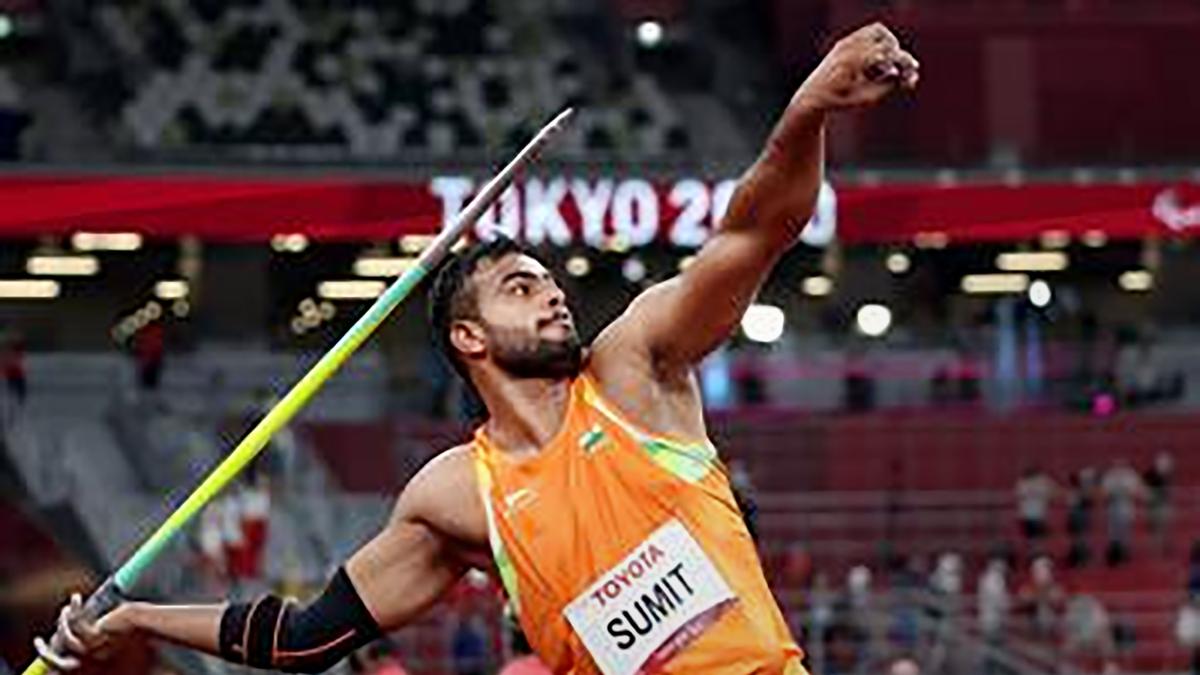Paris Paralympics 2024, Know Your Sport: Athletics, classifications and Indians in action
In para athletics, the sport class is in the following format- alphabet (T for Track, Marathon and Jumping events and F for Field events) + first digit (class type) + second digit (level of impairment). In general, the lower the second digit, the higher is the level of impairment.
JAVELIN THROW
The sport involves athletes running on a designated runway and throwing a metal-tipped javelin as far as possible inside a designated sector. The throw is only valid if the metal tip of the javelin hits the ground first. No other technique except throwing the javelin over the shoulder or upper part of the throwing arm is valid.
How distance is measured – The distance from the point at which the javelin struck the ground to the inside edge of the arc at the end of the runaway along a line to the centre of the circle of which the arc is a part.
Format – The competition will consist of a single round in which each athlete will get six attempts. The best distance out of the six throws will count as every athlete’s final distance.
Classifications (language specified by World Para Athletics) in which Indians will be participating:
F41 – shorter stature
Indian in action – Navdeep
F46 – Athletes with a unilateral upper limb impairment roughly comparable to the activity limitations experienced by an athlete with a unilateral amputation of one arm through or above the wrist and one intact arm. Athletes with bilateral upper limb impairments where one arm meets the unilateral criteria and the other affected arm does not meet the bilateral criteria above also compete in this class.
WATCH | Chinese players are not invincible, says para badminton star Bhavina Patel
Indians in action – Rinku, Ajeet Singh, Sundar Singh Gurjar, Bhavanaben Ajabaji
F54 – Athletes have full power and movements in their arms but no power in their abdominal muscles and typically no sitting balance. An athlete with partial to full trunk control but with upper limbs that have muscle power in the finger flexor and extensor muscles with always some weakness and resulting wasting of the intrinsic muscles of the hand is appropriately placed in this class. The grip on the implement is close to able-bodied, and force can be imparted to the implement when throwing.
Indian in action – Dipesh Kumar
F57 – Athletes who meet one or more of the MDC (Minimum Disability Criteria) for impaired muscle power, limb deficiency, impaired passive range of movement and leg length difference, who do not fit any of the previously described profiles, fall into this class.
Indian in action – Parveen Kumar
F64 – Athletes with unilateral below-knee limb deficiency competing with a prosthesis where the minimum impairment criteria for lower limb deficiency and leg length discrepancy are met.
Indians in action – Sumit Antil, Sandeep, Sandip Sanjay Sargar
HIGH JUMP
Competitors in this event take off from one foot over a four-metre-long horizontal bar and try to clear the greatest height without knocking the bar down.
Format – The competition will consist of a single round in which all competitors have three attempts per height. They can also decide to ‘pass’ one height and raise the bar before trying three times to clear the existing one. However, three consecutive failures on the same height or even a combination of heights lead to elimination. In case of a tie between competitors at the same height, the one with the fewest failures at that height is declared the winner. If the tie still exists, the athlete with the fewest failed attempts across the competition is declared the winner. In case the athletes can’t still be separated, the athletes concerned are given the existing positions unless the tie is for the first position which then leads to a jump-off where each athlete has one jump at the next greater height.
READ | Roland Garros to Grand Palais: All you need to know about Paris Paralympics 2024 venues
Classifications (language specified by World Para Athletics) in which Indians will be participating:
T47 – Athletes with a unilateral upper limb impairment resulting in some loss of function at the shoulder, elbow and wrist and which impacts sprints primarily. The impact of the impairment is comparable to the activity limitations experienced by an athlete with a unilateral through wrist/ below elbow amputation.
Indians in action – Nishad Kumar, Ram Pal
T63 – Athletes with a single through knee or above knee limb deficiency competing with a prosthesis where minimum impairment criteria for lower limb deficiency are met.
Indians in action – Mariyappan Thangavelu, Sharad Kumar, Shailesh Kumar
T64 – Athletes with unilateral below-knee limb deficiency competing with a prosthesis where the minimum impairment criteria for lower limb deficiency and leg length discrepancy are met.
Indian in action – Praveen Kumar
CLUB THROW
Competitors in this event sit in a throwing frame inside a circle consisting of a chair and a vertical pole. While sitting on the chair and holding the pole, the athletes try to throw a roughly 400g heavy wooden club as far as possible.
How distance is measured – From the first point of contact by any part of the club to the inside of the circumference of the circle along a line to the centre of the circle.
Format – The competition will consist of a single round in which every athlete will get six attempts. The best distance out of the six throws will count as every athlete’s final distance.
Classifications (language specified by World Para Athletics) in which Indians will be participating:
F51 – Athletes use the slightly decreased to full muscle power at the shoulders, elbow flexors, and wrist extensors for throwing an implement. The triceps muscles are non-functional and may be absent. Muscle power in the trunk is absent. The grip of the implements is difficult due to non-functional finger flexors. The non-throwing hand usually requires strapping to the support bar.
Indians in action – Amit Kumar, Dharambir, Pranav Soorma
ALSO READ | Which athlete has won most medals at Paralympic Games?
SHOT PUT
For the categories in which Indians will be participating, the athletes are required to ‘put’ the shot, a spherical-shaped object made of solid iron, brass or any metal not softer than brass, instead of the usual throwing from a designated circle as seen in the shot put events.
How distance is measured – From the nearest mark made by the fall of the shot to the inside of the circumference of the circle along a line to the centre of the circle
Format – The competition will consist of a single round in which every athlete will get six attempts. The best distance out of the six attempts will count as every athlete’s final distance.
Classifications (specified by World Para Athletics) in which Indians will be participating:
F31-38 – Co-ordination impairments (hypertonia, ataxia and athetosis)
Indians in action – Bhagyashri Jadhav (F34), Arvind (F35), Manu (F37)
F40 – Short stature
Indian in action – Ravi Rongali
F46 – Upper limb(s) affected by limb deficiency, impaired muscle power or impaired passive range of movement
Indians in action – Sachin Sarjerao Khilari, Mohd. Yasser, Rohit Kumar, Amisha Rawat
F57 – Lower limb(s) competing with prosthesis affected by limb deficiency and leg length difference
Indians in action – Soman Rana, Hokato Hotozhe Sema
DISCUS THROW
Competitors sitting in a throwing frame, consisting of a chair, inside a circle inside a U-Shaped Discus cage will try to throw the discus as far as possible.
How distance is measured – From the nearest mark made by the fall of the discus to the inside of the circumference of the circle along a line to the centre of the circle.
Format – The competition will consist of a single round in which every athlete will get six attempts. The best distance out of the six attempts will count as every athlete’s final distance.
Classifications (specified by World Para Athletics) in which Indians will be participating:
F51-57 – Limb deficiency, leg length difference, impaired muscle power or impaired range of movement
Indians in action – Kanchan Lakhani (F53), Sakshi Kasana (F55), Karam Jyoti (F55), Yogesh Kathuniya (F56)
400M
T20 – Intellectual impairment
Indian in action – Deepthi Jeevanji
T47 – Upper limb(s) affected by limb deficiency, impaired muscle power or impaired passive range of movement
Indian in action – Dilip Mahadu Gavit (T47)
100M, 200M
T12 – Vision impairment
Indian in action – Simran
T35 – Co-ordination impairments (hypertonia, ataxia and athetosis)
Indian in action – Preethi Pal
1500M
T11 – Vision impairment
Indian in action – Rakshitha Raju


